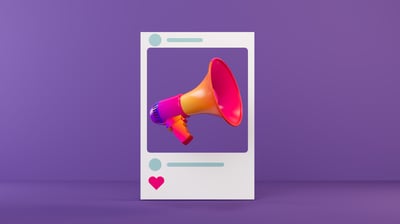June 13, 2019
.png?width=400&height=150&name=Tim-Ferguson-Profile%20(1).png) by Tim Ferguson / June 13, 2019
by Tim Ferguson / June 13, 2019

Traditional marketing professionals were expected to be a natural at creating and delivering great marketing presentations.
With the advent of digital marketing, however, the importance of old-school presentation skills are often overlooked or given little significance in a marketer’s skill set.
Modern marketers aren’t required to go door-to-door handing out pamphlets and flyers. The level of face-to-face interaction in marketing has been reduced to occasional networking events or marketing conferences.
However, the ability to create an effective marketing presentation is still a prized skill in modern digital marketing. There are several use cases where this prowess will come in handy, such as:
Apart from being comfortable speaking in front of a group and using slideshow presentation software such as PowerPoint, Keynote, Google Slides, or Prezi, there are some general guidelines which can be applied to any marketing presentation ideas that will ensure efficacy in terms of engaging your audience, creating sales interest, and ultimately driving the message home.
|
TIP: Check out the easiest-to-use presentation software available! |
The following five guidelines will help you create a marketing presentation that is both effective and engaging.
Start your social media and marketing presentation with a bang by asking a dramatic question tailored to your audience’s most pressing pain points.
For example, if your topic is something on the lines of how to improve your content marketing ROI, you can start with a provoking remark such as “B2B organizations waste almost $1 billion annually in incompetent and ineffective content marketing, are you contributing to that?” or maybe something like “60-70% of B2B content created is never used because the topic is irrelevant to the buyer audience. So, is your content actually useful or junk?”
Igniting your audience’s emotions and painting a vivid picture of their problems will force them to pay attention to your presentation. Oli Gardner, who is well-known for his inspiring presentations on conversion rate optimization, has a striking approach to his presentations. He starts off by presenting a few gloomy, despairing slides, and once the audience is amply dejected, he swoops in with good news.
The purpose of all this is to get them hooked right off the bat, to seize their attention and get them focused on what you have to say.
| RELATED: Check out these 10 Tips for Presenting to Executives from our friends at Sales Hacker. |
Once you’ve got them interested in what you have to present, it is time to make some legit promises, just as you do in your everyday digital marketing activities. For instance, while creating a pay-per-click ad, you write a persuasive copy that promises to solve the reader’s problems, getting them to click through to your landing page. Similarly, if you are writing a blog post, you use the power of storytelling to convince them to take some action such as click a call to action (CTA).
Have you ever seen a tutorial on YouTube? The next time you do, note how all the finest quality videos are the ones in which the presenter makes it crystal clear what you’ll achieve within the first 30 seconds if you watch the entire video. They show you the end-result as proof that they know what they’re doing, and you’ll get what you came for.
So, in the case of the aforementioned remarks on content marketing ROI, you can promise your audience that you’ll show them the exact strategies you used to achieve your goals (rankings, traffic, conversions, etc.).
The point is, the start of your presentation should be all about answering the famous copywriting question: “What’s in it for me?” Make it apparent within the first five minutes that your presentation is going to solve their problems and will provide them with actionable takeaways.
Of course, making these explicit promises means you also have to fulfill them. In fact, go above and beyond in delivering what you promised by following the wise adage “underpromise and overdeliver.”

The one thing common among all effective presentations is how they leverage storytelling and real-life examples to drive the point home.
There are some truly amazing marketing quotes, but the best, most succinct one is: “At its very core, marketing is storytelling.” by Melinda Partin. The same applies to your presentations. Essentially, your audience is more likely to engage with your content if they find it highly relatable and personal. A story offers that sense of connection by introducing a character (fictional or otherwise) who has a problem you can solve. It creates a scenario that cannot be ignored by the audience.
So, as you go through your slides, use practical, real-life examples to bind the presentation together cogently. It's as simple as telling how you or someone else implemented what you are trying to convey.
That said, ensure all your examples and illustrations are backed by data-driven marketing from reliable sources. Your slides should clearly specify the information source. The last thing you want to hear is “get your facts straight” while giving a presentation.
| Related: Check out over 100 creative presentation ideas that will wow your audience. |
How many times have you sat through a presentation where the slides are so brimming with text that it makes the whole presentation ineffective?
Don’t do that. As you may have heard, the average human’s attention span today is pitifully low. And when it comes to paying attention to elaborate presentations in conference settings, or remote presentations using a screen sharing tool, it could be even worse. Your audience likely has far better and more urgent things to do than listen to you and your wordy slides.
So, what do you do? Work to simplify your slides and include only the key points as written text instead of cramming them with the text you’re supposed to speak (and explain). Use slides to support speech, not replace it. And just like with stories and examples, include as many visuals (images, GIFs, videos) as possible to aid understanding.
|
TIP: Check out how to embed a YouTube video in PowerPoint. |
Besides, the more slides, the better. Instead of speaking to one slide for several minutes, spread your content around multiple slides. Use numerous images to illustrate your point, and keep the slides moving. This will help tackle the issue of dwindling attention spans.
Furthermore, make sure you use high-quality images. They may look fine on your computer, but images often become blurry after projection on a bigger screen. So be sure to check that. There are plenty of great websites that offer first-rate stock photos and illustrations for free, such as Unsplash, Pixabay, and unDraw.
Also, if you don’t have a graphic designer and there’s a dire need to whip up some good-looking graphics or remove/edit the background of some image you wish to include in your slides, consider using intuitive online tools such as Canva and AutoClipping, respectively.

Just because you are presenting in a serious context, doesn’t mean your presentation has to be boring or bland. Including some jokes here and there will increase audience engagement and retention of your content.
So, give your slides a facelift by enriching them with relevant humor. This can take the form of witty wordplay, GIFs, and even memes. However, make sure the humor is, in fact, relevant to the content you’re presenting and not a distraction. Don’t make it seem forced but natural.
Most memes available on the internet are of low-quality and resolution, you’ll have to take some time to create your own original memes. Don’t worry, though. Creating memes is a fun little activity and doesn’t take a lot of time. Use online tools like Imgflip or Meme Creator which allow you to upload your own image and overlay meme-style text with ease. As for GIFs, you can use GIPHY has a huge library of GIFs and refined search functionality, so you’ll be able to find all the GIFs you need there.
Don’t leave your audience hanging at the end of your presentation. Tell them exactly what to do next: is this the part where they can ask questions and clarify their doubts? How should they use the information you’ve just presented to solve their problems?
Reiterate all of the most important points explained in the presentation and make sure the value you promised at the start of the presentation is actually delivered. If your presentation lacked two-way communication and audience participation, now is the time to have a proper exchange of ideas and casual debates. Lastly, as it was a marketing presentation, it makes sense to end it with a definite CTA that conveys the exact action you want your audience to take.
Read our review of the best presentation software that can truly elevate your slides to the next level.
Tim Ferguson is a writer and editor of Right Mix Marketing blog. He enjoys writing about SEO, content marketing, online reputation management, social media, AI and Big Data. When he is not writing and editing for Right Mix Marketing, he spends time on learning more about content marketing and getting better at it. You can follow him on Twitter at @RightMixMktg
If you’re having trouble getting started with lead nurturing on Instagram, you’re not alone.
 by Rafaella Aguiar
by Rafaella Aguiar
With its wide global advertising audience, it's no wonder that Instagram has great potential...
 by Val Razo
by Val Razo
If you’re just starting a brand or business, one of the biggest challenges is getting people...
 by Kai Tomboc
by Kai Tomboc
If you’re having trouble getting started with lead nurturing on Instagram, you’re not alone.
 by Rafaella Aguiar
by Rafaella Aguiar
With its wide global advertising audience, it's no wonder that Instagram has great potential...
 by Val Razo
by Val Razo


